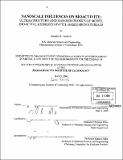Nanoscale influences on bioactivity : ultrastructure and nanomechanics of model bioactive hydroxyapatite based biomaterials
Author(s)
Vandiver, Jennifer M. (Jennifer McKeehan)
DownloadFull printable version (24.60Mb)
Other Contributors
Massachusetts Institute of Technology. Dept. of Materials Science and Engineering.
Advisor
Christine Ortiz.
Terms of use
Metadata
Show full item recordAbstract
There is a significant need for improved synthetic materials as orthopedic implants to replace human bone lost and damaged due to disease or injury. Certain ceramics, such as hydroxyapatite (HA), have the special property of being bioactive, meaning that an interfacial bond between the implant and the surrounding tissue forms, leading to good fixation. Bioactive ceramics are being investigated in a wide variety of forms for use in different bone implant applications. Three model synthetic HA based bioceramic systems were examined; phase pure, dense, polycrystalline HA; phase pure, dense, polycrystalline HA with 0.8 wt% silicon substituted into the lattice (SiHA); and phase pure, dense, nanostructured HA (nanoHA) with grain sizes less than 100 nm. SiHA has shown markedly enhanced bioactivity over non-substituted HA yet they have similar micro- and meso-scale properties and nanoHA has shown increased bioactivity over traditionally structured HA although they are chemically identical. The form of a biomaterial, the nanoscale surface chemical properties (e.g. surface functional groups, charge distribution, Hamaker constant), and morphological structure (e.g. grain size, shape, distribution, roughness) will govern its interaction with the biological environment. (cont.) The three main processes thought to occur upon implantation of a bioactive material are the adsorption of ions and biomolecules, formation of calcium phosphate layers, and interactions with various cells [5]. These physiochemical processes are expected to be highly dependent on nanoscale properties since this is the length scale of proteins and cell membrane adhesion molecules. The direct measurement of ultrastructure and nanoscale surface forces of model HA based biomaterials through atomic force microscopy and positionally- and chemically-specific high resolution force spectroscopy compared with in vitro and in vivo data will lead to better understanding of the impact these properties have on the physiochemical processes occurring at the biomaterial-biological interfaces influencing bioactivity. Although numerous studies of HA based biomaterials have been reported, there has been little clarification of the molecular mechanisms influencing bioactivity, partly due to lack of rigorous analytical tools for characterizing nanoscale physical and chemical surface properties. Quantifying all possible contributions to bioactivity is critical to the optimization, development, and design of new HA based biomaterials.
Description
Thesis (Ph. D.)--Massachusetts Institute of Technology, Dept. of Materials Science and Engineering, 2006. Includes bibliographical references.
Date issued
2006Department
Massachusetts Institute of Technology. Department of Materials Science and EngineeringPublisher
Massachusetts Institute of Technology
Keywords
Materials Science and Engineering.